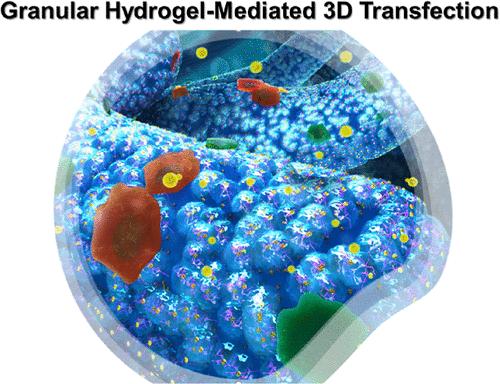当前位置:
X-MOL 学术
›
ACS Appl. Mater. Interfaces
›
论文详情
Our official English website, www.x-mol.net, welcomes your
feedback! (Note: you will need to create a separate account there.)
Transforming Cell–Drug Interaction through Granular Hydrogel-Mediated Delivery of Polyplex Nanoparticles for Enhanced Safety and Extended Efficacy in Gene Therapy
ACS Applied Materials & Interfaces ( IF 8.3 ) Pub Date : 2024-07-22 , DOI: 10.1021/acsami.4c05425 Jing Zhang 1 , Ximeng Sun 1 , Yongyuan Heng 1 , Yunfeng Zeng 1 , Yijia Wang 1 , Yu Shen 1 , Anhui Peng 2 , Wenzhe Tang 2 , Ming Zeng 3, 4 , Ziyi Yu 1
ACS Applied Materials & Interfaces ( IF 8.3 ) Pub Date : 2024-07-22 , DOI: 10.1021/acsami.4c05425 Jing Zhang 1 , Ximeng Sun 1 , Yongyuan Heng 1 , Yunfeng Zeng 1 , Yijia Wang 1 , Yu Shen 1 , Anhui Peng 2 , Wenzhe Tang 2 , Ming Zeng 3, 4 , Ziyi Yu 1
Affiliation

|
The utilization of hydrogels for DNA/cationic polymer polyplex nanoparticle (polyplex) delivery has significantly advanced gene therapy in tissue regeneration and cancer treatment. However, persistent challenges related to the efficacy and safety of encapsulated polyplexes, stemming from issues such as aggregation, degradation, or difficulties in controlled release during or postintegration with hydrogel scaffolds, necessitate further exploration. Here, we introduce an injectable gene therapy gel achieved by incorporating concentrated polyplexes onto densely packed hydrogel microparticles (HMPs). Polyplexes, when uniformly adhered to the gene therapy gel through reversible electrostatic interactions, can detach from the HMP surface in a controlled manner, contrasting with free polyplexes, and thereby reducing dose-dependent toxicity during transfection. Additionally, the integration of RGD cell adhesion peptides enhances the scaffolding characteristics of the gel, facilitating cell adhesion, migration, and further minimizing toxicity during gene drug administration. Notably, despite the overall transfection efficiency showing average performance, utilizing confocal microscopy to meticulously observe and analyze the cellular states infiltrating into various depths of the gene therapy gel resulted in the groundbreaking discovery of significantly enhanced local transfection efficiency, with primary cell transfection approaching 80%. This phenomenon could be potentially attributed to the granular hydrogel-mediated delivery of polyplex nanoparticles, which revolutionizes the spatial and temporal distribution and thus the “encounter” mode between polyplexes and cells. Moreover, the gene therapy gel’s intrinsic injectability and self-healing properties offer ease of administration, making it a highly promising candidate as a novel gene transfection gel dressing with significant potential across various fields, including regenerative medicine and innovative living materials.
中文翻译:

通过颗粒状水凝胶介导的聚合物纳米粒子的传递来改变细胞与药物的相互作用,以增强基因治疗的安全性并延长疗效
利用水凝胶进行 DNA/阳离子聚合物复合物纳米颗粒 (polyplex) 递送,显着推进了组织再生和癌症治疗中的基因治疗。然而,由于聚集、降解或与水凝胶支架整合期间或整合后难以控制释放等问题,与封装复合物的功效和安全性相关的持续挑战需要进一步探索。在这里,我们介绍了一种可注射基因治疗凝胶,通过将浓缩的聚合复合物掺入致密的水凝胶微粒(HMP)上而实现。与游离的聚合复合物相比,当聚合复合物通过可逆的静电相互作用均匀地粘附到基因治疗凝胶上时,可以以受控的方式从HMP表面分离,从而减少转染期间的剂量依赖性毒性。此外,RGD细胞粘附肽的整合增强了凝胶的支架特性,促进细胞粘附、迁移,并进一步最大限度地减少基因药物给药过程中的毒性。值得注意的是,尽管整体转染效率表现一般,但利用共聚焦显微镜仔细观察和分析渗透到基因治疗凝胶不同深度的细胞状态,突破性地发现局部转染效率显着提高,原代细胞转染率接近80% 。这种现象可能归因于颗粒状水凝胶介导的聚合物复合物纳米颗粒的递送,这彻底改变了聚合物复合物和细胞之间的空间和时间分布,从而彻底改变了“相遇”模式。 此外,基因治疗凝胶固有的可注射性和自愈特性易于管理,使其成为一种非常有前途的新型基因转染凝胶敷料候选者,在再生医学和创新生命材料等各个领域具有巨大潜力。
更新日期:2024-07-22
中文翻译:

通过颗粒状水凝胶介导的聚合物纳米粒子的传递来改变细胞与药物的相互作用,以增强基因治疗的安全性并延长疗效
利用水凝胶进行 DNA/阳离子聚合物复合物纳米颗粒 (polyplex) 递送,显着推进了组织再生和癌症治疗中的基因治疗。然而,由于聚集、降解或与水凝胶支架整合期间或整合后难以控制释放等问题,与封装复合物的功效和安全性相关的持续挑战需要进一步探索。在这里,我们介绍了一种可注射基因治疗凝胶,通过将浓缩的聚合复合物掺入致密的水凝胶微粒(HMP)上而实现。与游离的聚合复合物相比,当聚合复合物通过可逆的静电相互作用均匀地粘附到基因治疗凝胶上时,可以以受控的方式从HMP表面分离,从而减少转染期间的剂量依赖性毒性。此外,RGD细胞粘附肽的整合增强了凝胶的支架特性,促进细胞粘附、迁移,并进一步最大限度地减少基因药物给药过程中的毒性。值得注意的是,尽管整体转染效率表现一般,但利用共聚焦显微镜仔细观察和分析渗透到基因治疗凝胶不同深度的细胞状态,突破性地发现局部转染效率显着提高,原代细胞转染率接近80% 。这种现象可能归因于颗粒状水凝胶介导的聚合物复合物纳米颗粒的递送,这彻底改变了聚合物复合物和细胞之间的空间和时间分布,从而彻底改变了“相遇”模式。 此外,基因治疗凝胶固有的可注射性和自愈特性易于管理,使其成为一种非常有前途的新型基因转染凝胶敷料候选者,在再生医学和创新生命材料等各个领域具有巨大潜力。











































 京公网安备 11010802027423号
京公网安备 11010802027423号